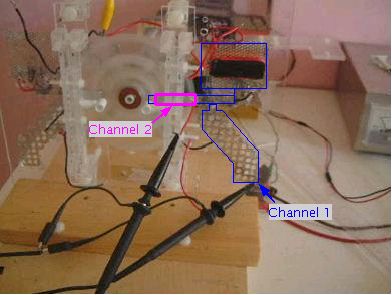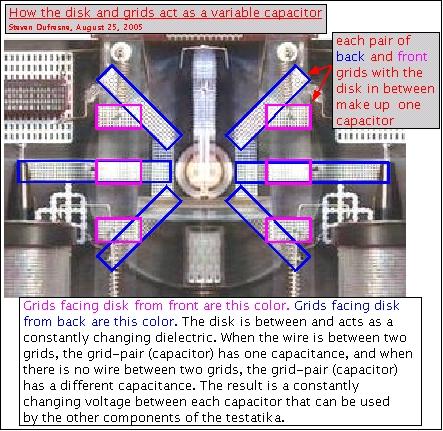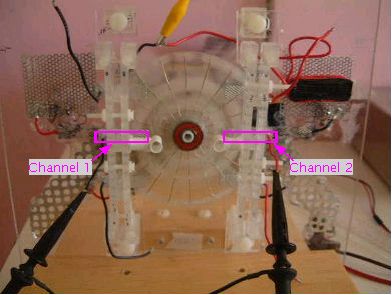A series of tests were done to determine the voltage waveforms of the various grids around the disk circumference in order to determine their purpose.
In many of the oscilloscope shots below, and especially the traces from the back grids, the main wave is the 60Hz sine wave coming from household wiring. Previous measurements, for testbed 1, were done using the oscilloscope probes incorrectly for a floating voltage source. These are done correctly.
C-Shaped vs. Flat facing grids
The grids on the sides that face the disk in the testatika small machine are C-shaped, where the two ends of the C are facing the disk and the flat part is further away. Seeing that not much voltage was being gotten out this way, the grids were flattened completely so that all of it would be close to the disk. Higher voltages were obtained that way.
|
|
All the remaining measurements are made with flat facing grids.
Variable capacitor testing
The following measurements were made. Details follow in the pictures below. Conclusions are mixed in with the details.
- Measuring voltages at front-side grid and back grids
- Measuring voltages at left and right front-side grids
1. Measuring voltages at front-side grid and back grids
The following results clearly show the behaviour of this disk arrangement as a set of variable capacitors. Note that two additional findings were particularly important:
- The closer the front and back grids were together, the higher the voltage.
- The back grid is composed of four separate pieces connected together by direct contact and by wiring (the following picture shows three of these pieces outlined in blue; the fourth is the bottom diagonal grid which is not outlined). The lower the resistance between all the connections, the higher the voltages for both back and front grids.
|
|
|
|
The above waveform matches the one shown here, obtained by another group. Each wire on my disk plays the same part as one half of their lamela. It is easier to see the waveform for a single pass by the pickup grids in their pictures since they had only one lamela and mine had 20 wires. Note also that they saw the same effect whereby the smaller the gap size between the electrodes, the higher the voltage.
|
2. Measuring voltages at left and right front-side grids
|
|
|
|
The reason for the above alternating voltages could be due to the some interaction across the disk face. Paul Baumann reportedly said that all the segments of the 3kW machine were connected at the middle with 100 watt resistors. Could this have been to limit interaction across the disk? In all photos of the small machine, the ends of the wires when they reach the middle of the disk are not visible. Could they be connected at the center via a high resistance ring?
Another possibility is something to do with the fact that the two sides in this small machine are not really symmetrical when the direction of the disk rotation is taken into account. On one side the disk is descending and on the other side it is ascending. As it descends, the order in which it encounters the grids is reversed with respect to the order in which it encounters the grids when it ascends.
This remains a mystery.




